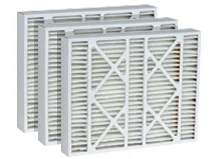It’s that time of year: pumpkin spice is on the menu and the leaves are falling again – time to get to work and prepare your home for the winter!
Fall is an ideal time to prepare your home–and HVAC systems for colder months ahead, through proper maintenance that ensures energy efficiency, safety, and comfort. Below, we’ll share 5 steps you can take to be sure that your home smoothly transitions from summer to fall.
Home Fall Maintenance Checklist
Key takeaways include: creating an extensive checklist focusing on gutter cleaning, roof inspection and furnace checks; understanding why such tasks are vitally important and why completing them regularly ensures longer-lasting HVAC system operation; performing roof and gutter maintenance inspections regularly; as well as understanding their significance to prolong HVAC life expectancy and ensure peak energy performance throughout.
HVAC and Indoor Air Quality
1. Change Your Air Filters
There's one super simple task you can start with that's easy with Filterbuy: change air filters in your HVAC system every 90 days to improve air quality and HVAC efficiency.
How-To: Follow our simple step-by-step guide to change the filter. Be sure to select the correct size and type for your system to keep it running smoothly.
2. Inspect Your HVAC System & Clean It Out
Keeping your HVAC system clean is an essential task for each season, not just fall. Clean vents, registers, and ducts regularly. For better pollutant capture, consider using electrostatically charged filters, which trap more particles than standard filters.
Professional Tip:Learn how dirty air filters damage your HVAC system and why cleaning is critical.
3. Check Out the Condition of Your Furnace
It's a great idea to get your furnace inspected by a heating professional before the winter season begins This is because a routine inspection can also help avoid issues such as noisy belts, sluggish behavior or inconsistent heating rooms.
Warning Signs: Listen for unusual noises or watch for inconsistent heating—these are telltale signs your furnace might need a tune-up. Consider reading our guide on common furnace problems and solutions.
Exterior Home Maintenance
The next place to look for seasonal tasks is outside your home. This is a pretty important step because it prepares your home for the harsher weather, no matter where you live. Check your roof, gutters, prep your faucets and seal up any leaks so the cold air can’t get inside. All these checks will help keep your home cozy during the winter months, and will help reduce your heating costs.
Seal Your Air Leaks
You'll want to make sure cold air isn't leaking into your home during the colder weather seasons. The solution is easy. Apply self-adhesive weatherstripping around your doors and windows. Install door sweeps to prevent drafts.
DIY Tip: You can test the effectiveness of your weatherstripping with a "Smoke Test". This is pretty easy: light a match or incense stick and see if the smoke is flickering near your doors or windows.
Check Your Roof
Look for missing shingles, loose seams, and other signs of damage. Bonus points for fixing roofing issues early: addressing these issues now can prevent leaks and costly repairs later.
Professional Advice: Have a professional inspection every three to four years or after major weather events to catch hidden problems. Also, inspect any roof-mounted antennas and wires—get rid of any that are no longer in use to prevent potential hazards. Consider reading about the importance of good indoor air quality during flu season when tackling outdoor and indoor home maintenance.
Clean Gutters and Downspouts
Clean those gutters! There will likely be an excess of water after a snowfall or icy conditions. This means that unless your gutters are clear, it can lead to damage. Regular cleaning keeps water flowing freely and protects your home’s exterior.
Gutter DIY Tips: It’s recommended to clean your gutters at least twice annually. Once in the fall and again in the spring. Consider installing mesh gutter guards to reduce debris buildup. If you’re uncomfortable with heights or the job seems too big, hiring a professional to do it. You can also add smart sensors to alert you of possible blockages in the future.
Protect Faucets from Freezing Temperatures
As temperatures drop, it’s important to protect outdoor faucets from freezing. This could cause pipes to burst and lead to costly repairs. Protect outdoor faucets from freezing with this method.
1. Disconnect hoses. 2. Shut off unnecessary valves. 3. Cover faucets with insulated covers. For in-ground sprinkler systems, follow the manufacturer’s guidelines to freeze-proof them and avoid damage.
Garden and Landscape Preparation
Here are some of our favorite ways to prepare your garden and lawn for the fall.
- Prune plants and lay down mulch to protect roots during the freezing months.
- Regularly rake leaves to prevent lawn damage.
- Winterize outdoor faucets and sprinkler systems to avoid freezing and damage.

Interior Home Maintenance
Seal and Insulate Your Home
Checking for air leaks and adding insulation where needed can make your home more energy-efficient and comfortable during the colder months.
Insulation Tips: Consider adding insulation in your attic, walls, or basement to help maintain a consistent indoor temperature and reduce your energy bills. Read more: Take it further with our guide on creating an allergy-proof home.
Test and Adjust Your Thermostat
As the weather cools, reset your thermostat to a more comfortable setting. A smart thermostat can help you monitor and adjust your home’s temperature even when you’re away, saving energy and money.
Check Smoke Alarms and Carbon Monoxide Detectors
Safety first—test your smoke alarms and carbon monoxide detectors regularly, and replace batteries as needed. Detectors older than 10 years should be replaced entirely.
Safety Tips: Learn about the importance of indoor air quality and heart health to enhance your indoor safety routine.
Ready Your Fireplace
Before lighting the first fire of the season, have your fireplace and chimney inspected by a professional. This prevents dangerous creosote buildup and ensures safe operation.
Safety Tips: Proper maintenance can help you avoid issues like indoor air pollution. Check the chimney flue for obstructions, inspect the brickwork for damage, and make sure the flue cap is securely in place. Store firewood properly—stacked neatly under cover and away from the house—to prevent pests. If you have a wood-burning stove, inspect it for safety and efficiency.
Safety and Security
Inspect and Service Your Fireplace and Chimney
To prevent fire hazards, it’s essential to have your chimney cleaned and inspected by a professional each year.
Tips: Get your firewood in early, double check that the fireplace damper is functioning properly and ensure gas lines are leak free if you have a gas burning fireplace.
Keep Firewood Dry
Properly storing firewood is crucial to prevent insect infestations and keep it dry for burning.
Storage Tips: Where you store your wood is key to keeping insects from invading it and keep it dry. To help avoid pest problems, store firewood under cover and at least 30 feet from the home.
Check Home Security Systems
Confirm your alarm, camera and motion detector are updated in good working order. Having regular testing and maintenance can give you peace of mind.
Upgrades: Install better locks and improve outdoor lighting to make your home more secure.
Repair Walkways
Cracks and raised areas in walkways, driveways, and steps could be dangerous to family members if icy conditions arise.
DIY vs. Professional: Sometimes minor cracks can be fixed using a DIY kit, while bigger issues may require help from the professionals. Waiting until this area gets more dangerous with ice.
Review Safety Features
An inspection of your home safety features will also help to keep the family out from danger.
Cleanup: Go through your home, removing old newspapers, hazardous chemicals, and flammable materials. Ensure that fire extinguishers are up to date and easily accessible, and review your family’s fire escape plan.
General Household Tasks
Declutter and Organize
Summer transitioning to fall is a perfect time to purge and re-arrange your house.
Pro Tip: Consider improving your home’s energy efficiency by identifying signs your home may not be energy-efficient.
Deep Clean the Home
Cleaning your home deeply before winter comes will keep that fresh ambiance.
Carpet Cleaning
Now is the time to give carpets a good Fall cleaning; decide whether it’s something you want to tackle on your own or hire out. Make sure to Deep clean other parts of your home as well like windows, light fixtures and closets.
Inspect and Clean Appliances
Make sure that your larger appliances (fridge, washing machine, dryer) are in good working condition. Performing regular maintenance on them can help to extend longevity and promote efficiency as well.
Water Heater
Prevent sediment buildup by draining your water heater annually to help it work efficiently and last longer.
Flip Your Mattress
Rotating your mattress head to foot every 6-12 months avoids sagging and ensures a better sleep.
Touch Up Exterior Paint
Fall is the perfect time to touch up any chipped paint on your home’s exterior, as paint adheres better in cooler, dry weather.
Conclusion
Fall is unquestionably an ideal time to give your HVAC system the TLC it requires in preparation for winter's harsh conditions. We recommend layering maintenance steps for maximum efficiency with minimum hassle later down the line and the satisfaction gained from staying ahead with simple proactive measures is great reward in itself!
Feeling inspired to get your home in order? Order some filters or get your HVAC serviced.


.webp)
.webp)
.webp)
.webp)







